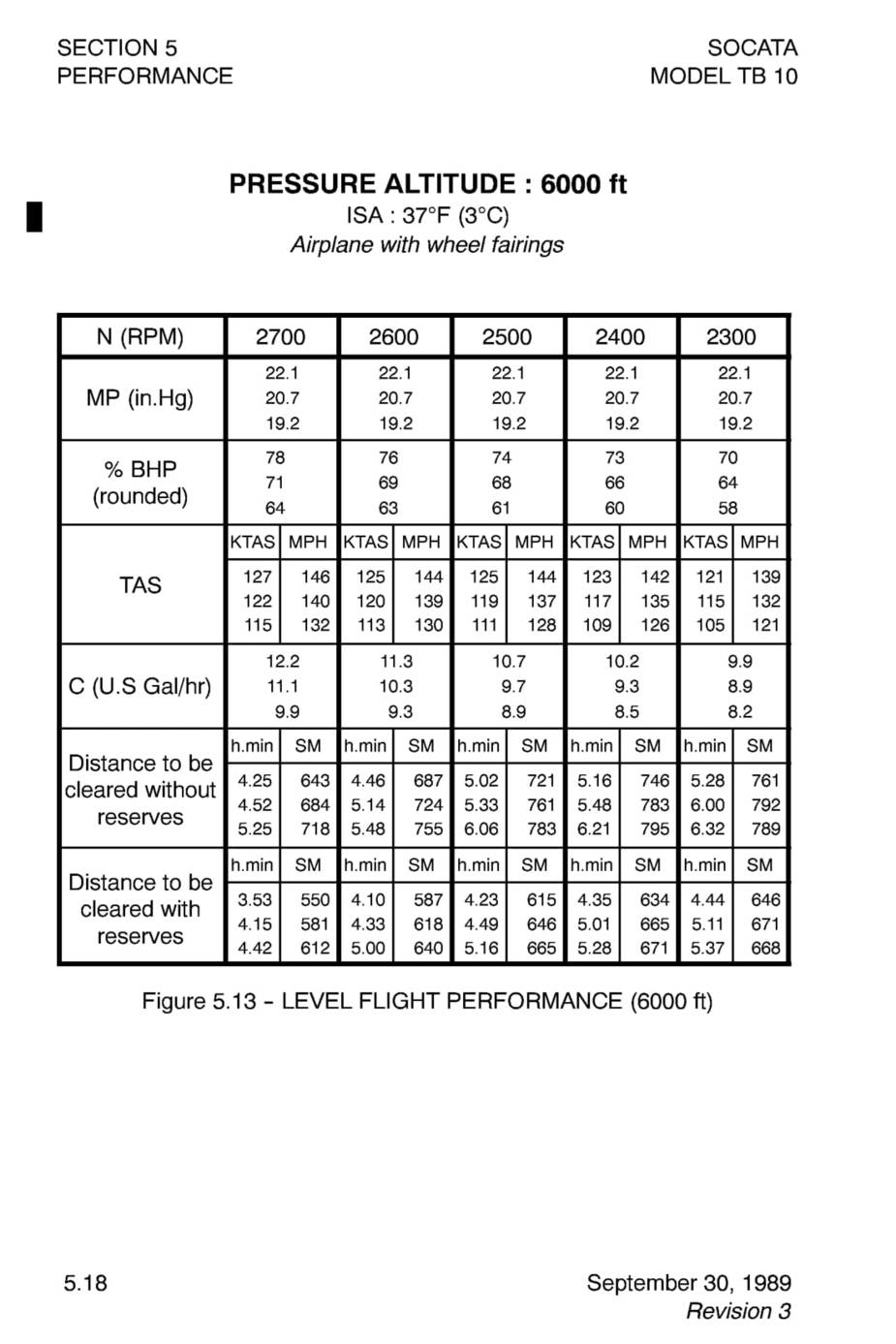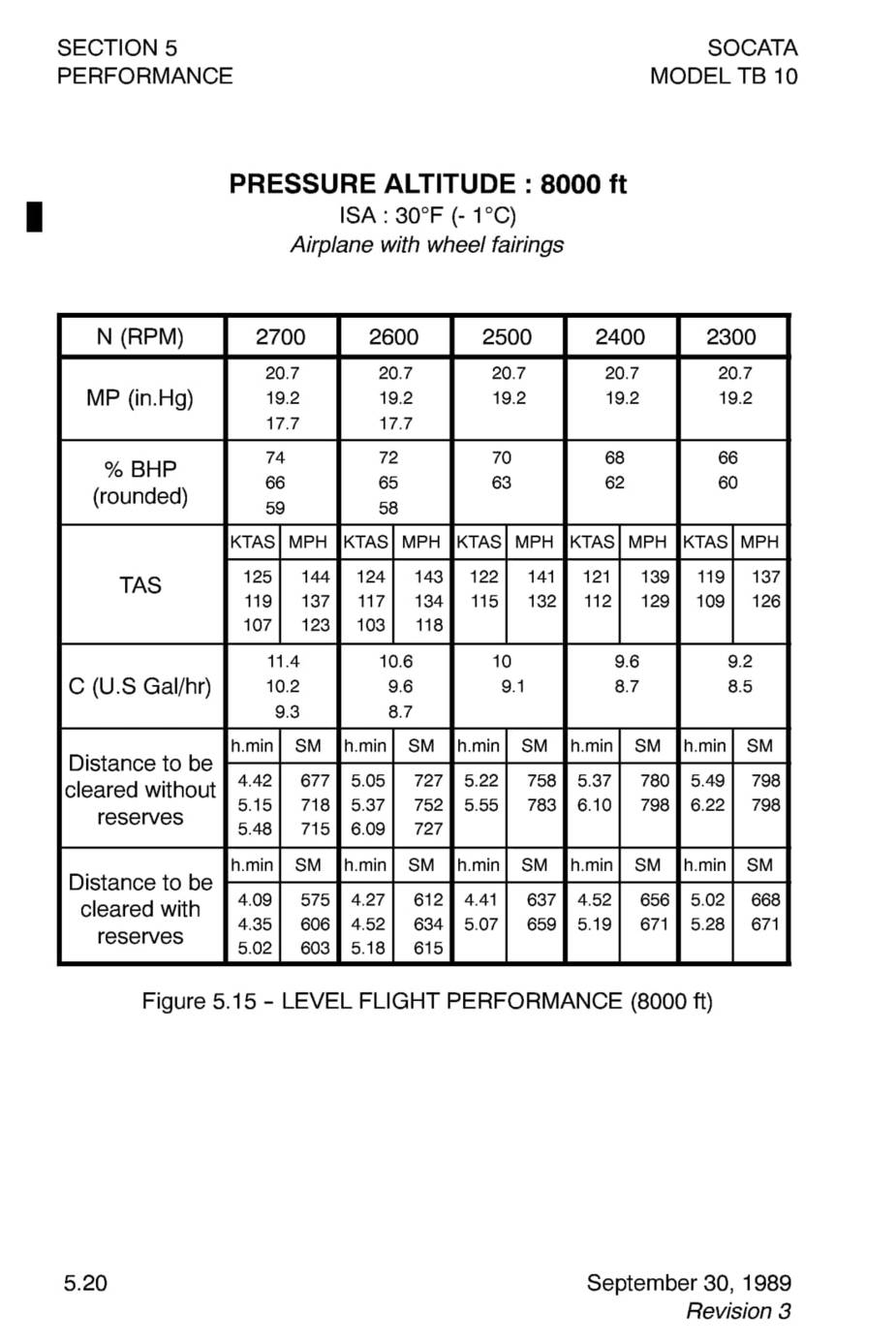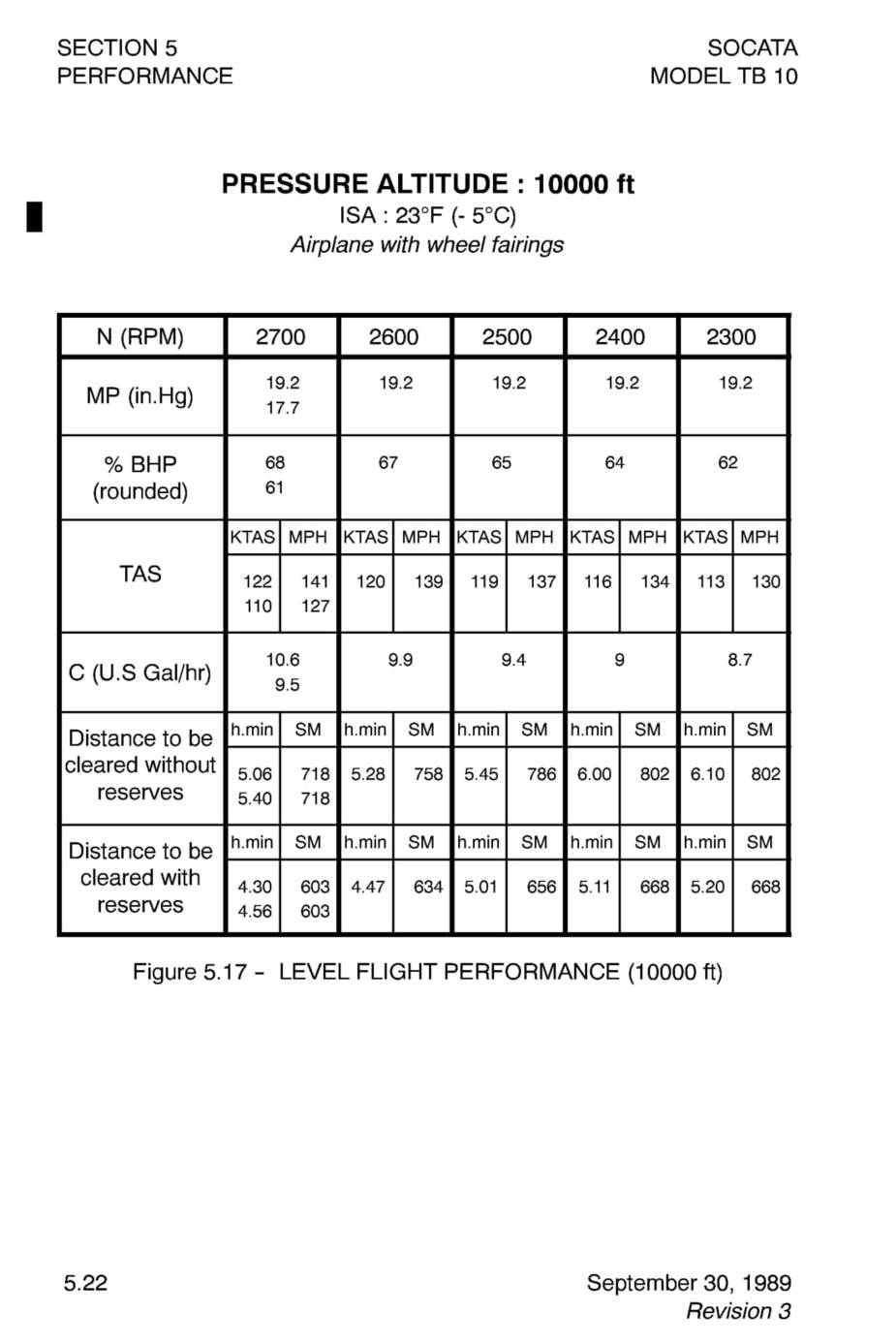Is this correct? I have noticed something odd.
I was checking some performance data and when I looked at the 6000ft and 8000ft tables in detail I was surprised that the MP values shown were so low for each altitude. Surely at these altitudes one flies a TB10 with a wide-open throttle…
Looking across the top row for each one the highest MP value given is 22.1in for 6000ft and 20.7in for 8000ft. In ISA conditions WOT will give you approx 24in at 6000ft (a common setting for me) and 22.2in at 8000ft so I wonder why they don’t show data for these settings.
So I further wondered, is it coincidence that the highest MP value shown for ISA 8000ft corresponds pretty much with the expected WOT value for 6000ft? And again why are they not showing WOT values, or why would they not, and how have they chosen the values that they do show? Surely you will not get the speeds given without using WOT at these levels – I certainly would not.
So I check the 10000ft table and sure enough, the highest MP value given is 19.2in – pretty much what you’d get with WOT in ISA conditions at 12000ft. It works the other way around as well – the highest value in the 4000ft table (not included below) is 23.6in, not too far from the 24in you’d get with WOT in ISA at 6000ft
Have they done something wrong here? The error, if there is one, could be anywhere. Each table could be titled incorrectly and thus referring to the wrong altitude in its entireity, or the just the row of MP info could be wrong with everything else being right. Or something else I’ve not thought of. You certainly aren’t going to get anything like 123KTAS in ISA conditions at 6000ft by backing the throttle off a whole 2in of manifold pressure from wide-open. There must be a problem with this info I think.



There should be a difference 1" or 2" Hg between ISA pressure and MP on the tables as WOT is not “open air” and you do get some MP reduction from air filtering system, depressurisation on engine intakes and carb heat….
I some aircrafts a +1" can be clawed back with a Ram/Cold air intake with no filters or warm up but I doubt you would get MP that close (or high than) to ISA pressure without a compressor/turbocahrger?
Perhaps that accounts for it, but I am fairly sure that I see quite a bit more than 22.1inHg of MP when WOT at 6000ft…
at 22.1" and 2700rpm you are at 78% power at 6000ft, so you will be able to see more but in theory you should get up to 24" on max rpm
Also, I wonder what your aircraft shows as MP at sea level at highest rpm and zero speed? that should give some confidence in engine gauges readings if the engine give the rated power
Good point. Have not checked that, one for the next flight (or departure) I think…
Manifold pressure gauge should be checked on the ground with the engine stopped. It should just read atmospheric pressure. Adjust altimeter to 0 ft, read the Kollsman window (pressure setting) and (for European altimeters) convert hPa to inches of Mercury (divide hPa by 33,85). That is, of course, if the altimeter is calibrated correctly.
On our TB10 MP gauge there are no markings above 25", so you would just be guesstimating – the needle goes into an unmarked area….
A non turbocharged engine can not exceed a pressure higher than ambient pressure. Looking at the ISA tables it becomes clear that the standard pressure at 6000 ft is about 23.98 inches and at 8000 ft about 22.22 inches. The performance tables do not necessarily give WOT but a set of specific power settings corresponding to various percentages of power. What wot really delivers may differ from that.
I would testfly it. Establish yourself at 6000ft and fly wot and best power mixture and record the values. Then try the regimes out of the poh. Do the results match?
I have found that very often when people.moan about wrong poh values it is because they are looking at something different than what the poh writes.
Mooney_Driver wrote:
Looking at the ISA tables it becomes clear that the standard pressure at 6000 ft is about 23.98 inches and at 8000 ft about 22.22 inches. The performance tables do not necessarily give WOT but a set of specific power settings corresponding to various percentages of power. What wot really delivers may differ from that.
This is the crux of my question. If they are not necessarily giving WOT values then (a) why not? – because you would generally fly WOT at those altitudes, (b) why have they picked the specific power settings they have? (it is not like they are nice round numbers) and (c) isn’t it a bit of a coincidence that the MPs given for one altitude actually correspond to standard pressure at the next listed altitude up? and (d) if they list the same highest MP value for each RPM, that suggests to me that they mean to list the highest obtainable.
Mooney_Driver wrote:
I would testfly it. Establish yourself at 6000ft and fly wot and best power mixture and record the values. Then try the regimes out of the poh. Do the results match?
I took some notes on my flights last week. Generally at 6000ft, with 2300 rpm and WOT and leaned for best power I was getting about 105 KIAS, which with QNH 1025 and +7 OAT gives 115 KTAS. This is close enough to ISA that it doesn’t change the KTAS output by more than one knot. This is somewhat beneath the 121 KTAS that the POH suggests should be achievable with 2300 rpm and only 22.1 inches of manifold pressure, which is less than WOT. I have always thought the TB10 POH figures somewhat ambitious but I’m not questioning the data per se, I’m wondering whether there is actually some kind of formatting/presentation/layout error where they’ve given the right figures for the wrong altitudes.
huv wrote:
Manifold pressure gauge should be checked on the ground with the engine stopped
That reading is less of use when flying but very useful for cross-checking QNH/FL settings of the altimeter to the airport elevation and guessing your “max MP” 
- With engine running WOT, max RPM, low ASI you should see that “max MP” minus say 2 inches (otherwise how fuel/air gets sucked in?) as ASI increases you get close to “max MP” minus say 1 inch as air intakes get full of air
- With engine running WOT, low RPM, max ASI you will be able to get that close to “max MP” but you are getting much %HP out of it (FF will go to zero plus some POH have this as limitation that can cause damage the engine)
It is the increase in ASI that increases the MP on WOT (tough hard to decouple from increase of the RPM)